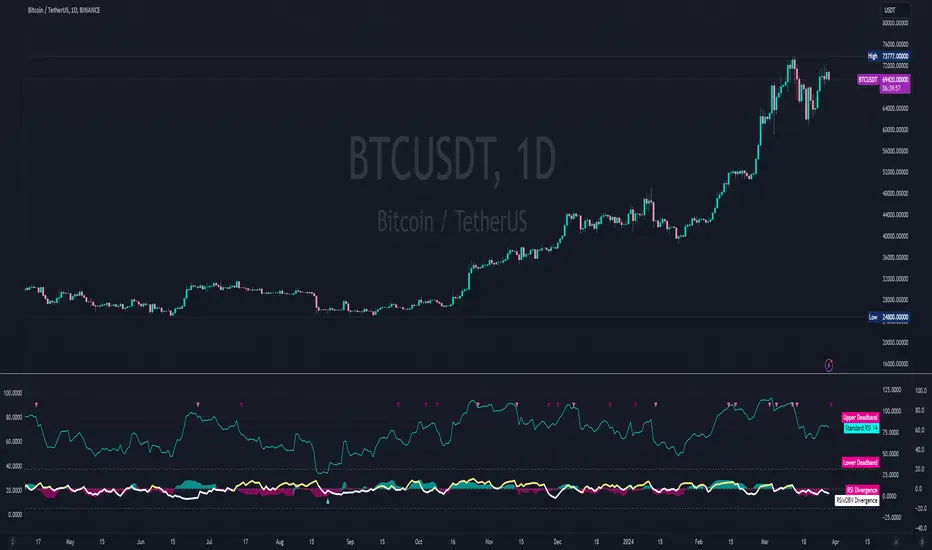PROTECTED SOURCE SCRIPT
已更新 3 Seas RSI Wave Oscillator

Traditional Triple RSI Oscillator combining a Fast, Normal, and Slow RSI to achieve high accuracy entry and exit strategies. This indicator is UNIQUE because it uses a mathematical filter to trim false signals from the RSI, thus creating a reliable RSI driven entry and exit indicator represented by red and green arrows. For additional functionality divergences are identified and live plotted. UNIQUELY Alongside the 0 axis an OBV function is charted relative to the RSI to allow OBV and RSI divergences to be observed on equal mathematical scales, this is exceedingly useful to observe relative strength at pools of liquidity. The three main configured RSI's are also plotted for traditional usage case but can be removed.
Green arrow indicates a Buy opportunity optimized for standard Dollar Cost Averaging strategies.
Red arrow indicates a Sell opportunity optimized for standard Dollar Cost Averaging strategies.
Not Financial Advice.
Green arrow indicates a Buy opportunity optimized for standard Dollar Cost Averaging strategies.
Red arrow indicates a Sell opportunity optimized for standard Dollar Cost Averaging strategies.
Not Financial Advice.
版本注释
Updated Title for cleanliness.版本注释
Added Alert Conditions for Buy and Sell conditions.版本注释
Modified the User Interface to be more compact and easier to navigate.Added a dark mode as requested.
Added an additional scalar to the Divergences.
Everything else is the same under the hood.
版本注释
Modified Scalp color for visibility.版本注释
Added tooltips to help users understand what they are doing.Added user requested deadbands to remove reversal singal frequency.
版本注释
Found a wave to improve the identification of reversals.Added equal treatment to the OBV as I had provided for the RSI. Now divergences may also be plotted on the reversal of OBV as a Yellow and White triangle on the chart.
Allowed RSI Plot to be completely hidden allowing for some to just use the RSI|OBV functions of this indicator as a alone.
Further improved the user experience by allowing the reversals to have a trigger before they show up. Allowing users to decide how sensitive they want their indicator to be even more based on the asset. (-3 is what was hardcoded previously for those who wish to have the previous value)
When both RSI and OBV are implying the same bullish momentum, color intensity will be increased for visual feedback.
版本注释
Screenshot update because Tradingview randomly ignores plot line visibility settings at times.版本注释
Fixed a bug introduced in the Dead-band so it should be working again.Removed BTC mode since it no longer makes sense.
Made the default divergence settings 0 to accommodate all timeframes. I myself use +3 on both RSI and OBV trigger values for TF's above 20 minutes.
版本注释
Updated the description for some of the tool tips to help clarify features.Be aware that when messing with the deadband you should have the source RSI's ON to see what exactly it is that you are excluding.
版本注释
Fixed Bug with OBV Reversal Alert and improved new source for usage. That said HLC3 is still the best for this technique however.版本注释
Unlocked Divider colors for customization, per mobile users request.Tightend OBV reversal and improved detection logic.
版本注释
To answer a lot of questions.In trading, the Relative Strength Index (RSI) and On-Balance Volume (OBV) are technical indicators that traders use to assess market conditions and potential price movements. A sharp divergence between these indicators can signal several things, depending on the context and how the divergence is manifesting. Here's a brief overview of what each indicator represents and what their divergence might mean:
Relative Strength Index (RSI): The RSI measures the magnitude of recent price changes to evaluate overbought or oversold conditions in the price of a stock or other asset. Typically, an RSI above 70 suggests that a security may be overbought or overvalued and may be primed for a trend reversal or corrective pullback in price. Conversely, an RSI below 30 indicates an oversold or undervalued condition.
On-Balance Volume (OBV): OBV is a cumulative indicator that uses volume flow to predict changes in stock price. The theory is that volume precedes price movement, so if a security is seeing increasing OBV, it is generally considered bullish; if OBV is declining, the trend is seen as bearish.
A sharp divergence between RSI and OBV could indicate several scenarios:
RSI showing overbought conditions while OBV is rising: This could indicate that although the price is high, the volume supporting this price level is strong, suggesting that the upward trend might continue despite overbought conditions. It can sometimes signal that a pullback might be short-lived or less severe.
RSI showing oversold conditions while OBV is declining: This might suggest that the price is low, and the selling volume is high, potentially indicating that the downward trend could continue despite the asset being in oversold territory. It could warn of further declines or a more pronounced bearish trend.
RSI diverges from price action: If the RSI is moving opposite to the price (e.g., RSI is rising while price is falling or vice versa), it indicates a divergence that could signal a potential reversal in the current trend. When this divergence occurs with corresponding movements in OBV (e.g., OBV rising while price and RSI are falling), it might strengthen the case for a trend reversal.
OBV diverges from price action: If the OBV is moving in the opposite direction of the price, it can signal that the current trend is weakening and may reverse. For example, if the price is rising but OBV is falling, it suggests that the price increase is not supported by volume, and the uptrend may not be sustainable.
It's essential to use this indicators in conjunction with context. No single indicator can provide a complete picture, and traders often use multiple data points and market analyses to inform their decisions. Divergences can be powerful signals, but they should be interpreted carefully within the broader market context.
版本注释
Screenshot update受保护脚本
此脚本以闭源形式发布。 但是,您可以自由使用,没有任何限制 — 了解更多信息这里。
免责声明
这些信息和出版物并非旨在提供,也不构成TradingView提供或认可的任何形式的财务、投资、交易或其他类型的建议或推荐。请阅读使用条款了解更多信息。
受保护脚本
此脚本以闭源形式发布。 但是,您可以自由使用,没有任何限制 — 了解更多信息这里。
免责声明
这些信息和出版物并非旨在提供,也不构成TradingView提供或认可的任何形式的财务、投资、交易或其他类型的建议或推荐。请阅读使用条款了解更多信息。